03-02: Herbaceous biomass – Supply chains
Herbaceous biomass resources are typically available on an agricultural field and, before being converted to an energy carrier, will need to be brought to an energy plant. This requires a series of steps that need to be performed: harvesting / extraction of the biomass on the field, transport, drying, comminution, storage, homogenization, compaction / densification, conveying and quality control. Some of the above steps may be excluded, while their order depends on the final process requirements, the biomass characteristics and economic considerations. Harvesting, storage and some sort of transport are almost always included in the supply chains of herbaceous biomass (the only minor exception being some pilot energy systems that operate directly on the field), while drying may well be excluded for most of the – already dry upon collection – herbaceous biomass sources.
Overall, the required of the above steps will comprise the overall supply chain for herbaceous biomass fuels. The important aspects for each
step will be presented in the following paragraphs, but the following overall key points need to be stressed in order to present a clear picture
of the differences of the supply chains for herbaceous biomass fuels compared to fossil fuels and/or woody biomass ones:
• The harvesting of herbaceous biomass is basically an agricultural activity, hence it is usually has a very narrow time span in which it
can be performed before weather conditions make its application impractical or impossible.
• For the same reason, herbaceous biomass from agricultural becomes available only for a specific time in the year. Unlike fossil fuels,
which are extracted all year long, and woody biomass fuels, which may have a more extended period of harvest (some residues of the wood industry
may also have a yearly availability), herbaceous biomass needs to be stored for periods of up to 12 months before its usage.
• The low energy density of herbaceous biomass is an important factor with an adverse influence on the overall economics and which tends
to limit potential applications (along with the potential impact on the energy conversion processes of the herbaceous biomass properties, see
Chapter 04-02). Also, the transport distance is likewise limited and the energy plants tend to be much closer to the source of biomass compared
to woody fuels.
Apart from the mostly negative aspects outlined above, there are some positive sides in the supply chains of herbaceous biomass fuels, the most important of which is the enhancement of the income in agricultural areas.
03-02-01: Harvesting / Collection
Harvesting (or collection) of a herbaceous biomass crop is the first step in any supply chain with this feedstock. The main point that has to
be considered is that harvesting of herbaceous biomass takes place in a field used for agriculture. Since most agricultural practices today are
highly mechanized, so is the case with herbaceous biomass harvesting. Some other key points, especially in comparison to the collection of other
fuel sources are as follows:
• Unlike woody biomass, herbaceous biomass is harvested in locations that are easily reachable and where existing standing plants usually
do not limit the operation. Hence, mechanization is easy in the vast majority of locations.
• Unlike fossil fuels and in part woody biomass, the "harvesting density" is lower and more ground has to be covered to in order to
collect the same amount of energy. This obviously has an impact on the economic side.
• Being an agricultural activity that is performed out in the open ground, harvesting of agricultural biomass can only be performed in a
limited time window, depending on plant type. For example, maize residues should be collected at most 30-40 days after grain harvest; after that
time, the weather and soil conditions do not allow field traffic. A further limitation is placed by the prevailing weather conditions during the
harvest window; harvesting may be delayed for example during rainy periods.
That being said, there are several possible ways to collect herbaceous biomass, some indicative options can be seen in Figure 03-02 1. The most important differentiations are on the physical form of the final product: bales, chipped material or pellets.
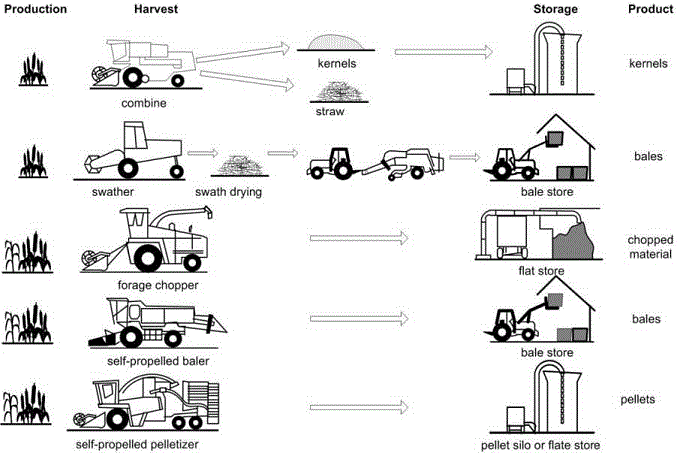 |
| Figure 03-02 1: Herbaceous biomass harvesting options (Source: Handbook of biomass combustion and co-firing) |
03-02-01a: Harvesting baled biomass
The most common harvesting method results in a final product in bale form. It is usually employed for agricultural residues: the main agricultural activity is grain harvesting, during which the remainder of the plant is cut and left on the field. The material is then collected in long rows using a windrower (Figure 03-02 2) and then baled using a baler (Figure 03-02 3).
This method has several advantages: first, the equipment used is generally easily available by the farmers; hence no additional costs are required. Second, provided that the weather conditions allow it and the farmers are willing to let the material lay in the field for some days or weeks, natural drying can occur and there is also the possibility of leaching chlorine and alkalis and improve the fuel quality (see section 03-02-03). Third, the biomass bales, which are the final product of this operation, are relatively easy to handle, transport and store.
On the other hand, this method has some disadvantages, one of the most important of which is that the herbaceous biomass is in contact with the soil for a long time. This is further aggravated by the fact that, for many agricultural residues, the protection of the residual material from vehicle movements is not a priority. Hence, during the harvest of the grain, the material may be run over by agricultural machines or trucks and become essential lost for any application. Obviously, this affects the biomass availability (see Chapter 02-02). Even if the material is harvestable though, there is a high possibility of baling stones and soil and of increasing therefore the biomass ash content. Finally, since several steps are required for the production of the final product, hence this method is more demanding in terms of manpower and equipment.
Depending on the baler employed, different bale size and shapes are possible. For a given machine, the bale density depends on the plant type; indicative values are presented in the table below. For bioenergy supply chain, only round and large square (Hesston) bales are of interest; small square bales and compact bales easier to handle for animal feeding or bedding but do not produce economies of scale required for bioenergy projects. Equipment research is driving towards the higher density balers, for a final bale weight of 1 ton.
| Parameter | Round bales | Large square bales | |
| Driving power | kW | > 30 | > 60 |
| Throughput | t/h | 15–20 | 15–20 |
| Density (per bale) | kg (d.b.)/m3 | 110 | 150 |
| Shape | – | cylindrical | cuboid |
| Density (storage) | kg (d.b.)/m3 | 85 | 150 |
| Dimensions | cm | Ø 120–200 | 120 x 130 |
| Length | cm | x 120–170 | x 120–250 |
| Weight (20% moisture) | kg | 300–500 | 500–600 |
| Table 03-02 1: Comparison of baling technologies for round and large square bales (Source: Handbook of biomass combustion and co-firing) | |||
Harvesting of baled biomass is also common for energy crops. Since in this case, the biomass to be used for energy applications is the main product, there is more flexibility in the agricultural works that can be employed. Hence, cutting and windrowing may be performed at the same step (this still allows for the natural drying of the biomass on the field) or, if the biomass moisture content is low enough, one-step combined harvesting and baling is possible.
After baling, the material may be stored for some time in the field (see storage consideration at section 03-02-05); afterwards, it is loaded on vehicles (see 03-02-08 for the loading process) and shipped to a storage area, a pelletizing plant or directly to the energy plant.
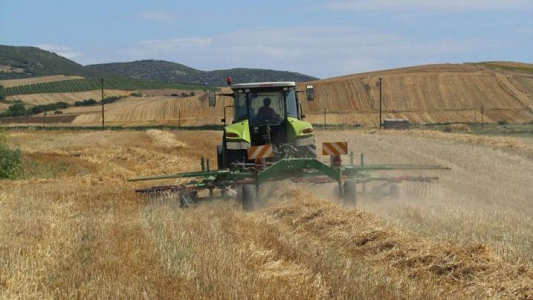 |
| Figure 03-02 2: Windrowing of straw (Source: CERTH) |
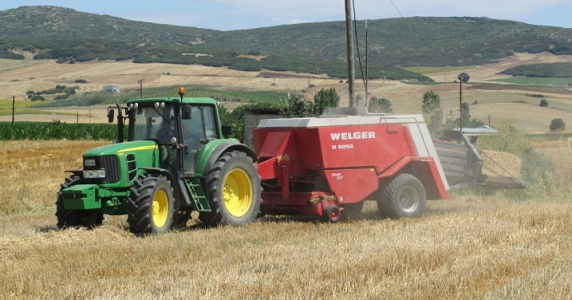 |
| Figure 03-02 3: Baling of straw (Source: CERTH) |
03-02-01b: Harvesting with forage harvesters
The second option is to harvest the whole plant at the same time using a forage harvester. The method is essentially the same as the one employed during silage harvesting. In order for this technique to be used, the plant must remain standing, so obviously it is not applicable for agricultural residues that are left on the field.
The advantages of this method is that the material can be loaded directly on a truck (see Figure 03-02 4); thus, the extraction of the biomass from the field is somewhat simplified. In addition, the material already undergoes a size reduction step during harvesting, hence, depending on the final application and its requirements, the grinding step may be simplified or omitted entirely.
The disadvantages are that the chopped material is highly susceptible to losses (e.g. through wind or rain), unless it is stored in closed compartment. Natural drying cannot be achieved in the field in this way; instead, the plant must be harvested at a time when its dryness is as low as possible. Finally, forage harvesters may not be readily available in an area and the costs of applying this harvesting method may be higher compared to standard baling.
Overall, harvesting with forage harvesters may present some advantages but its integration with a biomass supply chain is quite tricky; for this reason, this technique is not as widespread as is baling for energy applications. One exception is when silage is collected for biogas production, where a larger surface area available to bacteria and fungi can increase the biogas yield.
 |
| Figure 03-02 4: Harvesting of cardoon in Greece using a forage harvester (Source: CERTH) |
03-02-01c: Harvesting with mobile pelletizers
A final harvesting option is to directly produce pellets in the field. Pelletization has many advantages and potential for cost-savings (see 03-02-07), which on-field application intends to improve by avoiding the costly transport of baled biomass to a centralized pellet production plant.
There are two ways to produce pellets on field:
• Using a mobile pellet plant, such as those than can be carried by tractors or by a truck. Such systems usually operate with baled biomass and harvesting takes place
as normal. The cost avoid is the one of moving bales to the pellet plant.
• Using a self-propelled pelletizer. In this case, there is no need for the standard harvesting equipment.
Although promising, such systems are not widespread and are usually unavailable in a given location. Hence, their incorporation in a biomass supply chain demands significant investments on the part of the farmers or the contractor in charge of collecting the biomass. In addition, field trials with these units are – to our understanding – fairly limited, so more care must be exercised in their procurement and operation.
03-02-02: Transport
After harvesting, herbaceous has to be loaded on a vehicle and shipped to its next stop along the fuel supply chain: a storage facility, a pellet production plant or directly to the energy plant itself. As indicated in section 03-00-02b, the key consideration in the transport stage is the fuel energy density. For herbaceous biomass, the energy density is generally very low; for large square bales, which are the most common form of compacted material, it is in the range of 2 GJ/m3, which is very low compared to the bulk energy density of aroung 10 GJ/m3 for pellets or 20 GJ/m3 for coals. Hence, transport costs for herbaceous biomass per tonne of transported material are quite high and tend to limit the supply chains in distances of less than a 100 km, usually 50 km.
Bales of herbaceous biomass are loaded (see 03-02-08) on tractor trailers or truck trailers. Tractor trailers require more man-power for handling and transporting the fuel and the capacity is lower compared to trucks. The difference tends to increase the longer the transport distance is. However, the option of truck transport is available mostly in cases where straw delivery is arranged by a third contractor and not by the farmers themselves.
For a typical large bale size of 120 x 130 x 240 cm (weight of approximately 500 kg), the truck is loaded with 12 bales, plus another 12 bales on the trailer, distributed in two layers. This means that the overall transported weight is about 12 tn, which is less than half of the truck’s capacity. The bales need to be secured by straps and in some cases a net must also be used to avoid fly-offs.
In cases where the material is harvested by forage harvesters, it is loaded directly on road tractors or agricultural trailers. It is important to cover the material with a tarpaulin during transport in order to avoid contamination by road dust and also to limit material losses. In the case of energy crops, where the seeds of the plant are also harvested, it may be that the seeds will be swept from the container, hit the ground and end up sprouting in unwanted places. The transported density with some light-weight materials can be quite low. For cut straw for example, a figure of 45-50 kg/m3 is reported, which is about one third of the density of baled biomass. For heavier materials however, such as cardoon, the difference between chopped and baled biomass may not be so great.
Pelletization leads to a significant increase of the energy density and is commonly employed when there is a need to transport the fuel over longer distances. The transport of pellets is possible with a variety of vehicles: trucks, including specialized trucks for pellets, railway cars or boats and barges. There are few examples of long-distance supply chains with agropellets; in any case, since the pellets are usually transported in closed compartments so as to protect them from the weather conditions, the safety issues discussed in section 03-00-03 should be considered.
03-02-03: Drying
The moisture content of biomass is essentially an unwanted but unavoidable part of the fuel; it does not contribute to its heating value, it decreases the combustion efficiency and, from the supply chain point of view, it increases the amount of "inert" material that is transported, stored or handled and thus increases the cost of the supply chain. Also, the excessive presence of moisture tends to facilitate biological degradation; while this may be desirable in some processes (e.g. anaerobic digestion), it tends to pose significant storage issues.
The moisture content of herbaceous biomass upon harvest depends mostly on the plant type, the harvesting period and the weather conditions during that time. Typical values are given in Chapter 03-01; generally though, the moisture content of materials that are harvested in the summer, such as straw, is low, below 15% wt (in Greece, moisture as low as 6-7% upon harvest has been noticed). Maize residues, which are harvested in Autumn have a higher moisture content, around 20%, while plants that are harvested in the winter may have a moisture of 40% or higher. Thus, depending on the material and the process requirements, a drying step may or may not be included in the supply chain.
The easiest and cheapest option for drying herbaceous biomass is the on-field drying. This is achieved either directly before baling (by leaving the material in the field for a number of days) or by leaving the bales on the field. For materials that are harvested in good weather conditions, this allows for the quick drying of the fuel and thus moisture contents below 15% are fairly easy to reach.
For straw, if the weather conditions allow it, the material might be purposefully exposed to one or two rainfalls on the field, which leach potassium and chlorine and thus limit fouling and corrosion phenomena in the boiler (see Ash Appendix), and then be collected at a later stage, after its moisture reaches again normal levels. The material is then called "grey straw". Although it is a higher quality fuel than normal (or "yellow") straw, most farmers and contractors do not employ this method, since end-users make contracts based on weight and water content and do not differentiate their prices when grey straw is available.
For herbaceous biomass that is collected in more rainy seasons, this option may not be applicable and when biomass is collected relatively dry, it will need to be protected from moisture immediately. See section 03-02-05 on storage for more.
If for some reason, the moisture content of the herbaceous biomass is higher than the requirements of the process and there is no possibility for on-field drying, forced drying equipment (see also 03-00-02c) will have to be employed. Forcer dryers can be simple band conveyor using exhaust gas or heated air or more sophisticated rotary dryers. In both cases, it would make sense to provide the heat required for the drying process by burning some of the biomass itself (that is from a renewable energy source) or, if possible, by utilizing waste steam or flue gases from the process itself (that is by implementing energy integration measures).
03-02-04: Comminution
As indicated in section 03-00-02d, comminution is an essential part of practically any conversion process. The particle size that leaves the equipment used for size reduction depends on the requirements of the process, for example in pulverized fuel applications (04-02-02a) the particle size of biomass particles is 1-3 mm and even smaller for coal particles, while much higher particles can be handled by grate-fired systems.
One important difference regarding the comminution of biomass materials - especially herbaceous biomass – compared to solid fossil fuels is that although it is possible to get very small, almost spherical particles with fossil fuels, with biomass comminution usually results in elongated particles.
The first possibility to reduce the size of herbaceous biomass presents itself during the stage of harvesting; if forage harvesters are used (see 03-02-01b), then it is possible to get a chopped material. Its length will vary depending on the moisture content of the plant, the plant properties and the equipment employed, but generally speaking it should be possible to get to particle lengths of 40 mm and lower. The material will be highly inhomogeneous though (see Figure 03-02 7).
In most cases however, the material will be harvested and transported in the form of bales, and it is in this form that it must be processed by the size reduction equipment. Of the equipment described in 03-00-02d, the most common for herbaceous biomass are shredders and hammer mills. Shredders are used in most grate-fired applications, where the requirements for particle size reduction are not so great, while hammer mills are common in pellet production processes (03-02-07), where it is important to have a smaller size of particles and a more uniform mixture. Hammer mills are also used to break up pellets in large-scale pulverized fuel applications that co-fire biomass and coal (see 04-02-02b).
Whatever the equipment used, two general points can be made:
• It is important to remove as far as possible any impurities (e.g. large stones, metal, etc) that may come along with biomass in order to avoid damages to the size
reduction equipment. This applies also to the strings that tie the bales.
• The energy consumption for grinding biomass is quite high and increases the smaller the particle size is required to be. Thus, electricity costs for the operation of
mills in a pellet production facility or a pulverized fuel plant that operates with biomass pellets and uses a dedicated hammer mill for biomass grinding may be a
significant part of the overall cost.
03-02-05: Storage
Storage steps may be included more than once in the fuel supply chain. Generally, we can differentiate between long-term storage options and the energy plant storage space – the first have to provide solutions for the whole quantity of biomass to be handled, while the plant storage s much more limited in scope and serves mostly as a fuel buffer for those periods o time when fuel deliveries are not performed (e.g. weekends and holidays). The plant storage area is directly linked with the fuel feeding system and will be discussed in more detail in section 03-02-06. In this section, the focus is mostly on storage options beyond the energy plant’s limits.
As mentioned in section 03-02-01, herbaceous biomass feedstocks typically have a narrow harvest window – this means that the biomass is "available" once per year, while the dimensioning of the energy plant assumes yearly operation in order to optimize capital and operating costs. In some cases, such as the use of straw for heating, the month in which the biomass is available is completely outside the window of user needs. Hence, long-term storage – up to 12 months – is a requirement in most herbaceous biomass supply chains.
Storing the herbaceous biomass for such long periods of time does not simply mean providing sufficient quantities of the operation of a plant; the storage step should also aim to minimize any degradation of the biomass, so that its quality does not decrease. This means avoiding dry matter losses and/or changes in composition that result in lower fuel heating values. The cause of this losses and changes can be either weather conditions (leaching, erosion, etc) or biochemical degradation through fungi and microbes. The avoidance of large scale losses through fires and rodent infestations should also be considered by a storage system.
Since bales are the most common form of herbaceous biomass after harvesting, most storage systems are designed with the assumption that the biomass will be handled in a bale form. In order to minimize the required storage surface area, bales are usually stacked. Since large square bales are more usually stacked compared to round-bales, storage considerations are an important factor in the overall preference for square bales. However, large square bales may be preferable in cases where no roofed storage exists. In any case, bales should be as densely packed as possible in order shed moisture more easily. In addition, large bales are more susceptible to degradation due to the initial moisture than small bales, hence during baling moisture should be less than 17% in order to avoid dry matter losses during storage.
Generally, the storage options for bales are as follows:
• Storage under roofed compartments or, if possible under completely enclosed barns.
• Outside storage of bales that are under a removable cover or wrap.
• Outside cover of bales without any cover.
Table 03-02 2 presents some typical values of dry matter losses that can be expected for different storage types and durations. These values are only indicative, since the actual losses, apart from the storage type and duration and the initial moisture content, also depend on the biomass type and the weather conditions, e.g. rainfall, humidity level and temperatures. If the weather conditions limit the exposure of the bales to moisture, then biological activity is restricted and outside storage is possible. In wet and warmer areas, the losses may exceed 25% or result in the complete degradation of the bales, depending also on the initial moisture content of the biomass. The maximum value of acceptable dry matter losses is a subject of technoeconomic evaluations; generally though an order of 5% losses is considerable reasonable in order to keep the overall economics at acceptable levels.
| Storage Method | Range of Dry Matter Loss (%) | |
| Up to 9 months | 12 – 18 months | |
| Enclosed barn | < 2 | 2 - 5 |
| Under Roof | 2 - 5 | 3 - 10 |
| Covered, pad or elevated | 2 - 4 | 5 - 10 |
| Covered, on ground | 5 - 10 | 10 - 15 |
| Uncovered, pad or elevated | 3 - 15 | 12 - 35 |
| Uncovered, ground | 5 - 20 | 15 - 50 |
| Table 03-02 2: Typical values of dry matter losses for large roundbales per storage type and storage duration (Source: University of Wisconsin) | ||
Moisture is the key factor for controlling biochemical degradation and avoiding spontaneous combustion during storage. A large number of herbaceous agricultural residues and energy crops are harvested during the dry season, which means that the initial moisture content of the biomass can be quite low. Hence, storage of herbaceous biomass aims mostly to preserve the initial low moisture and does not act as a period of natural drying, as is the case with many woody resources (see Chapter 03-01). This means avoiding the increase of the bale moisture content through rainfall or direct contact with the dry ground.
Avoidance of moisture increases from the ground is fairly easy through the use of a pad or an elevated ground. In case of a pad, it should be porous and high enough to keep it above the water table and any run-off or flood water. A slope of 1.5% is usually required in order to enable water to flow away from the stack. Moreover, the pad should be strong enough to bear heavy machines loaded with bales. It can be constructed either with gravel of 45 cm depth or concrete that is at least 15 cm, or preferably 20 cm, thick.
As previously mentioned, outside storage of bales without any form of cover is extremely risky – experience indicates that once water sets on the top side of the bale, it is fairly easy to penetrate it whole length and ruin the whole quantity of the baled biomass. Hence, some form of cover is preferable. A common solution with low investment costs is coverage with tarpaulins (see Figure 03-02 5), reinforced plastic cloths of various qualities. Tarpaulins can be reused about 2 – 5 years, depending on the quality and the weather conditions. Old car tires or bales are frequently used on top of the tarps in order to prevent damages from high speed wind. However, tarpaulins leave the side of the stack unprotected. Therefore, this solution may not be the most appropriate when wind and rain is common in an area.
Another option for outside storage of bales would be to wrap them in a tube-wrapped system or individually (see Figure 03-02 6). Such systems essential store the biomass in anaerobic conditions and are fairly common for wet silages to be used as animal feedstocks; the wrapping was found to inhibit biological activity for feedstocks with moisture contents higher than 15%. For bales of dry material, wrapping can still be used, however the costs can be quite high – contrary to other storage systems the costs do not decrease significantly with the increase of the number of bales treated.
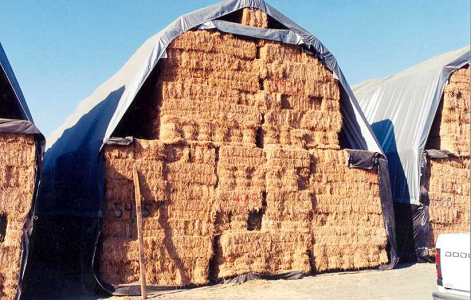 |
| Figure 03-02 5: Storage of bales under tarpaulin (Source: University of California) |
 |
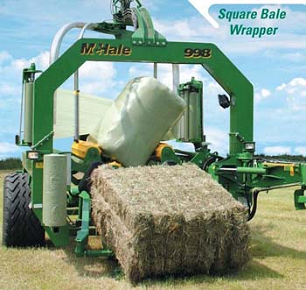 |
| Figure 03-02 6: A tube-wrapped system and stacker, left (Source: University of California) and a square bale wrapper (Source: McHale Engineering Limited) | |
The best protection for long-term storage is offered by large metal buildings (see Figure 03-02 7, left). Such buildings have walls at all sides and are high enough to store stacks of at least 8 layers of big square bales (9.6m of height). The floor can be constructed with concrete or flat gravel. Metal buildings should be high enough for trucks and other machinery to get in and provide maximum protection from weather conditions, arsons and rodents. Pole barns or fabric buildings (Figure 03-02 7, right) are an alternative, although they are usually employed whenever there is pre-existing infrastructure (for pole barns) or for fiscal reasons (for fabric buildings, because they are not permanent installations). The life-time for metal buildings is approximately 50 years or more, and slightly lower for pole barns. For fabric buildings, the guaranteed life-time is 15 years, although it may reach 20 years in favorable conditions.
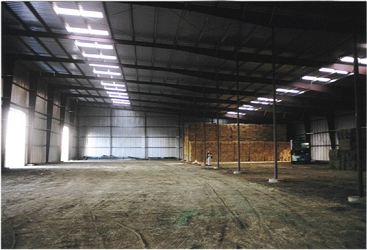 |
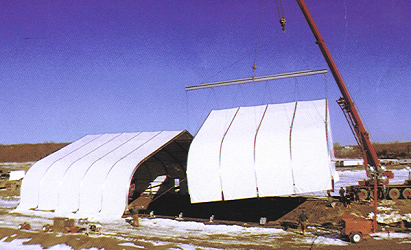 |
| Figure 03-02 7: Interior of metal building for bale storage, left and erection of a fabric building, right (Source: University of California) | |
In some cases, herbaceous biomass will be pelletized before storage. Due to the increase of the bulk density, the storage area required will be much less and the material can form a pile, as can be seen in Figure 03-02 8. The pellets will be fairly dry (moisture < 15% wt), hence the risk of degradation is not as great as in the case of wood chip piles; however, safety precautions should be considered (see sections 03-00-02e and 03-00-03 for more) as pellets may self-ignite. The most important factor is that the pellets need to be kept dry; if they are exposed to moisture, then they may break apart. For this reason, a roofed (in most cases completely closed, like a silo) storage space is required; open storage is not an option.
 |
| Figure 03-02 8: Bulk storage for straw pellets (Source: mixBioPellets Project) |
03-02-06: Homogenization
Most herbaceous biomass materials will consist of different parts of the plant. For example, maize residues are made up of stalks, leaves and cobs. Some important properties of these parts vary, e.g. moisture content and ash content and composition, as a result of the different function of its part in the plant’s life. Therefore, it is easy to understand that baled herbaceous biomass is actually very inhomogeneous. The same can be said for biomass collected through forage harvesters (03-02-01b), since the size reduction step is not enough to completely homogenize the material (see Figure 03-02 9).
Homogenization in the case of herbaceous biomass is usually achieved by a size reduction step (e.g. shredding, milling, etc) before the conversion process or pelletization. For more, check section 03-02-04.
 |
| Figure 03-02 9: Cardoon harvested with forage harvester. The inhomogeneous nature of the material is apparent and pieces of stalk, leaves, bracts and seeds can be distinguished. (Source: CERTH) |
03-02-07: Compaction / Densification
A high bulk density is critical for minimizing the costs in several important steps of the supply chain: mostly transport, but also storage is affected. The material that is collected from herbaceous biomass residues or energy crops is a very lightweight fraction; hence some sort of compaction is required not only to increase the bulk density but also to make it more manageable and less prone to losses from weather conditions (e.g. material that gets blown away by the wind).
The most common sort of densification is baling; it is discussed in section 03-02-01, is a part of the vast majority of herbaceous biomass supply chains and takes place at the earliest possible stage of the supply chain. The bulk density that can be achieved by baling depends on the adopted technology and the size of the bales. Typical values would be around 150 kg / m3 (500 – 600 kg per large bale). Baling may not necessarily need to a large increase of the bulk density over the raw material, but it facilitates handling and storage.
In cases where further densification is required, one must employ the pelletization process. The final products, pellets, are small cylindrical particles, with typical diameters in the range of 6 – 8 mm and a length up to 40 mm. The density of the particles is usually around 1200 kg/m3; the bulk density of pellets is typically close to 600 – 650 kg/m3, about 4 times higher than that of baled biomass.
Pelletization of herbaceous biomass is a well proven technology. It is mostly used for the production of animal feed and bedding material; straw pellets for energy plants are also quite common. However, the number of installations producing herbaceous biomass pellets for energy purposes is limited mostly due to the limited number of end-users and the lack of established markets for such materials, contrary to wood pellets.
The production steps of pellets from herbaceous biomass are as follows:
• Reception (see section 03-02-06) and screening and grinding of raw material (see section 03-02-04). It is important
in this step to remove the strings that tie the bales, large stones, metals and any other impurities that the bales may contain in order to avoid the wear of the equipment.
Figure 03-02 6 presents a schematic of this process.
• Drying (see also section 03-02-03). In order to produce pellets of good quality (e.g. that do not break down easily) it is important to have
a moisture content below 15% wt (typically between 8 - 14%). Many herbaceous biomass resources already fulfil this requirement, especially in southern European countries,
and can therefore be pelletized directly without having to be artificially dried. The savings that are achieved in this way are very important: the equipment cost of the
drier may be almost half of the total costs of the pellet plant, while the energy consumed by the drying process is very high if the material it too moist (as is the case
with many forest residues). In cases where a pelletizing plant deals with both herbaceous biomass and woody biomass, a drier will be present but used only for the woody
fuels. Too dry materials though may result in very brittle pellets that easily break down into dust. Hence, moisture may need to be added before pellet production (see
conditioning below).
• Conditioning. In this stage, steam and/or water is used to soften the material fibres prior to densification. This leads to the formation of stronger pellets and
lower fines. Other binding agents or additives that improve the combustion characteristics may be used at this stage; the overall aim is to improve the pellet quality.
However, some additives may be prohibited in certain countries or their use would limit the end-uses of pellets. Conditioning is said to not work so well with straw-like
materials, but it is an important part of the process when wood or mixed pellets are produced.
• Pelletizing. This is the core step of the process. Several different pellet mills concepts exist; some mobile units have even been developed that enable the
pelletization of baled biomass directly on the field and skip most of the above processes (except for grinding). In general, there are no major issues with pelletizing
herbaceous biomass if a pellet mill has been designed for such materials. The most typical problems that may occur are die blocking (quite common with straw like material)
and overheating, as well as the higher abrasion wear due to the higher ash (and in particular silica) content of such fuels.
• Cooling. Pellets leave the pellet press at a temperature of ~ 100 oC and need to be cooled down before packaging, otherwise they might break up.
• Packing and screening of fines. Any fines that leave the pellet press need to be separated from the final product and can be recycled in the process. The pellets
themselves are either put in small bags (20-25 kg, for residential end-users and not so common with pellets from herbaceous biomass) or big bags (1-1.5tn). Alternatively,
they may be transported pneumatically or stored in bulk (see 03-02-05).
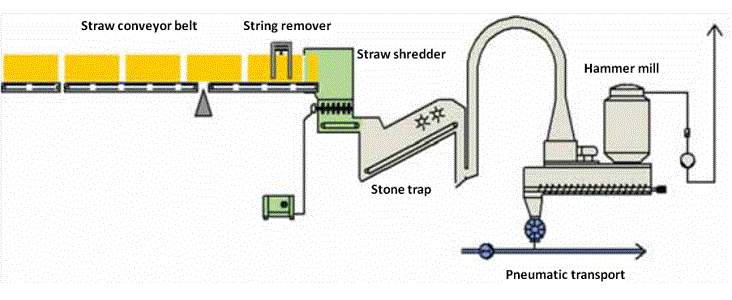 |
| Figure 03-02 10: Straw handling at Studstrupværket plant. The same principle applies to the pre-treatment of straw for the production of pellets (Source: DONG Energy) |
The addition of a pelletization step in the supply chain results in significant increases in the fuel cost, mostly due to the investment required and in part due to the energy requirements of the process (electricity for the operation of mills and presses, heat for drying, etc). Overall, pelletization may cost 2 – 4% of the fuel heating value if no drying is required or up to 20% if there is need for drying. However, the cost savings can be significant if transport over long distances is required. For example, wood pellets from Canada can be shipped economically to harbours in Western Europe (and the GHG emissions of the supply chain are low enough as to be no question whether the use of this fuel actually contributes to the overall reduction of GHG). For herbaceous biomass pellets, such long supply chains have not yet materialized, due to the lack of large markets for these fuels.
Some equipment manufacturers produce mobile pellet units (small enough to fit in the back of a truck or be carried by a tractor) that can be present in the field where the biomass is produced. Using these machines, it is possible to produce pellets directly on the field and avoid the higher transport costs of bales to the pellet plant. Such systems are still not so widespread however and would require careful planning in order to produce significant cost savings. Models for self-propelled pelletizers have also been developed (see 03-02-01c).
The torrefaction process, in combination with standard pelletization is a pyrolysis process that promises the production of pellets with higher energy densities, as well as with other favourable properties for applications (ease of milling, hydrophobic qualities, etc). More info can be found in section 04-02-06 for herbaceous biomass it is still a process in the stages of development.
03-02-08: Handling / Conveying
In the context of this handbook, handling refers to operations that are performed on the field or the storage location. The most important is loading baled biomass from the field to a vehicle or to a stack of bales. Different machines can be used for this procedure: front loaders, excavators, tractor shovels, telescope loaders or mini loaders. A comparison of handling time per bale for each system is presented in Figure 03-02 11. Tractor shovels and telescope loads can handle two bales at a time, hence the handling time is reduced. This can lead to significant time savings for operations that handle a number of straw bales.
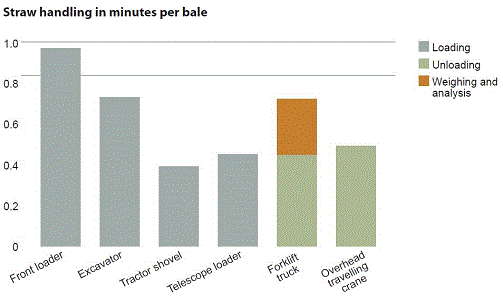 |
| Figure 03-02 11: Comparison of straw loading and unloading technologies. (Source: Straw to Energy, 2011) |
Telescope loaders (see Figure 03-02 12) have a greater lifting capacity and can reach further so that the bales of straw can be stacked high, which reduces storage costs. Telescope loaders are therefore becoming more and more widespread. The mini-loader is not quite as common, but is very flexible and can be used in tight locations.
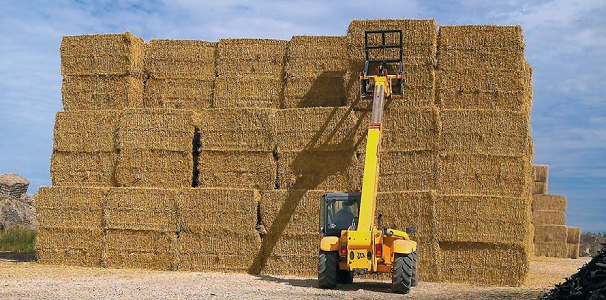 |
| Figure 03-02 12: Stacking straw with a telescope loader. (Source: Straw to Energy, 2011) |
Within the limits of the power plant handling (or conveying) covers the following operations: unloading of the material from the transport vehicle, storage within the limits of the power plant and "transport" from the plant storage area to the comminution equipment and from there to the boiler, gasifier or reactor.
As can be expected, the technology process, the level of automation and the overall set-up of the conveying process depends on the size of the energy plant and the form in which biomass is handled. Thus, for herbaceous biomass, a conveying system most often relates to bale handling; after comminution, milled biomass may be transported in the system, but usually over very short distances.
Unloading at large plants is usually performed with an overhead crane system. Such systems can grip up to 12 bales at a time, hence an entire lorry unloaded in two lifts. Weighting and moisture measurement (see 03-02-06) is performed at the same time. The unloaded bales are stacked in the closed storage area, where the crane is located. The storage area typically has room to store bales for 2-3 days of operation in order to compensate for the lack of fuel deliveries during weekends and holidays. The same crane is used for loading the cranes on the conveyor belts that lead to the size reduction equipment. It is common for energy plants to divide the storeroom in two equal parts; each part has its own crane system and a truck unloading lane so that plant shutdowns are avoided when a crane is non-operational. Figures 03-02 13 and 03-02 14 present such a crane system.
For smaller plants, the specific investment in overhead cranes is quite high and bales are unloaded from the trucks using a fork lift, which handles 1-2 bales at a time. Although the unloading time is comparable to the crane system, as can be seen in Figure 03-02 11, further time is required for weighting and measuring the moisture content of the bales.
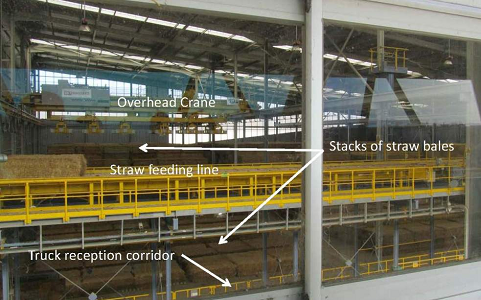 |
| Figure 03-02 13: The straw handling system at ACCIONA power plant (Source: CERTH) |
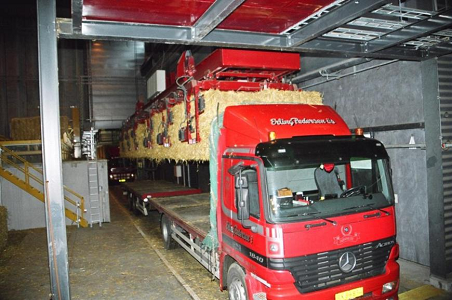 |
| Figure 03-02 14: Unloading straw bales at the Køge Biopellet Factory (Source: mixBioPellets Project) |
Following the size reduction step (section 03-02-04), the milled or shredded biomass needs to be transported to the compartment where the energy transformation process takes place. In most case, the process will be direct combustion. For grate-fired systems and fluidized beds(see 04-02-02b), the shredded biomass is typically transported via screw conveyors; for pulverized fuel systems, that is mostly in co-firing power plants (see 04-02-02b), pneumatic transport is required in order to inject the biomass particles in the boiler.
Figure 04-02 2 also presents an overview of the straw bale handling system for a large scale biomass power plant.
Handling of herbaceous biomass pellets is essentially no different than the handling of woody pellets, as described in 03-00-02h. Pelletization means increased fuel costs, as discussed in 03-02-07. However, the handling of pellets is much easier and the whole conveying system becomes much more compact: instead of large storage areas with crane systems pellets can be stored in tall silos where they can be loaded and unloaded with fewer dust issues. Pneumatic systems are fairly common for conveying pellets within the confines of a power plant.
03-02-09: Quality control
Due to the effect of several unpredictable factors, such as weather conditions, on the fuel supply chain, the quality of herbaceous biomass fuels that is actually delivered at the energy plant can be highly variable. Certain parameters, such as the ash content and the higher heating value, exhibit a more limited range of variations that depend mostly on the biomass type, growth conditions and fuel logistics. Hence, most plants that are fed with herbaceous fuels do not perform the whole range of fuel characterization tests on a daily basis. Emphasis is placed mostly on the fuel weighting and the determination of the moisture content.
Larger energy plants equipped with overhead travelling cranes (see Figures 03-02-13 and 03-02 14) allow for the quick measurement of both weight and moisture content during unloading. At smaller plants, portable hydrometers are used for the measurement of moisture. It should be noted that portable hygrometers are not as accurate in the case of relatively "loose" materials, such as straw bales.
The exact limits on the moisture content depend on the plant operators and the adopted process; typically though, bales with moisture contents higher than 20% wt are discarded and sent back to the farmers.
In cases where pellets are the final delivered fuel, the pellet mechanical durability is another critical parameter. Pellets with low durability tend to break up during handling and form fine particles, which increase the risks of material losses, dust explosions or even health risks. For systems designed to operate with pellet feed, too much fines will also lead to increased unburnt emissions and a decrease of the efficiency. The pellet mechanical durability is measured according to European Standard EN 15210; a pellet quantity is put in a closed compartment and, after a set number of rotations, it is put in a 3.15 mm sieve. The amount of fines generated by the process is indicative of the pellet durability, which is expressed as the percentage of the final non-fine material to the initial mass. The accepted values of the pellet durability depend on the end-user, typically though they are over 96 – 97%.
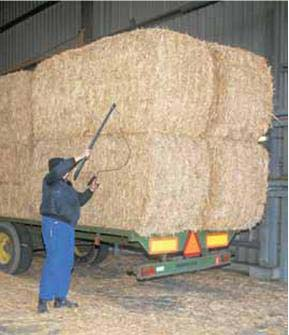 |
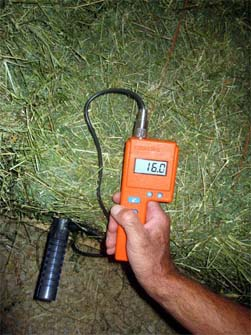 |
| Figure 03-02 15: There are a great number of moisture meters available on the market, many of which are designed primarily to detect moisture in buildings and building materials including wood and straw bales. See for example this site. As long as the meter has a needle-shaped sensor it will work also work for straw bales aimed for fuel. The left picture (Source: Torben Skøtt/BioPress), shows a typical situation and the right one how a portable instrument originally aimed for use in agriculture may look. | |
03-02-10: Planning aspects
Compared to woody biomass, there are fewer actual applications of herbaceous biomass for energy production and hence, fewer supply chains that are actually implemented. The system planner will have to "borrow" best practices from the existing examples, as well as from other applications, such as the use of agricultural residues for animal feeding and bedding.
One of the most important considerations in a herbaceous biomass supply chain is that it is essential link between the energy production plant and the fuel producers, e.g. the farmers. Farmers have a pretty good idea of how their products are valued in the food or fibre market, but the energy market is currently not so well known. Therefore, a system planner would have to consider certain educational and dissemination actions that will stress out which feedstock characteristics are important to the end user (for example, as low an ash content as possible) and how the agricultural operations will have to consider these requirements.
In theory, a power plant is paying the fuel supplier in terms of the fuel energy content; in practice and in order to avoid more costly and lengthy measurements only weight and moisture content may be measured upon delivery (see 03-02-09). However, any variations in the fuel quality will show in the long run and may result in the black- listing of certain producers or even – in extreme cases – in the abandoning of a project. Therefore, all involved actors should consider the risks involved.
Generally, plant operators prefer not to be directly involved in the fuel supply chain and leave this job to contractors. Thus, on his/her part, a plant operator will see a fuel delivery cost, expressed in €/GJ or a similar unit but may be unaware of the actual steps required for the supply chain to work. The system planner will have to consider how to facilitate the build-up of a supply chain based on the equipment and facilities already present in a given area. For example, large square balers will be available in most areas where straw is produced; this may not be the case in areas where other crops are available and whose residues are burnt on the field. The purchase of such equipment by the farmers or the contractors will have therefore to be considered. Mobile pelletizers may sound good in practice, but their application becomes more complicated when it has to be decided how the cost of their purchase will be distributed. The same applies to storage facilities or the inclusion of forage harvesters in the supply chain.
On the other hand, the plant operator should not expect that the farmers will implement techniques that improve the fuel quality, such as straw leaching , unless there is a procurement mechanism that sets increased prices for fuels of higher quality.
The weather conditions in a given area are a critical parameter that has to be considered in the supply chain design, since they affect the harvest window and storage requirements.
As a result of the biomass availability, the low energy density and the high transport costs of herbaceous biomass, most supply chains with these materials tend to be limited to 50 – 100 km from the field. This may limit the site of the energy plant to agricultural communities or small cities and therefore will affect the possibility of finding potential customers for the heat produced from a CHP unit.
Due to the low transport capacity, a plant of any given size will require a significant number of trucks moving in and out of its boundaries each day for fuel deliveries. This is an important source of noise and pollution and local authorities may require that the plant be located outside of a municipality’s premises. Obviously, this affects the piping cost for a CHP unit, see also 04-00-08j.
Pelletization may be considered for the transport of herbaceous biomass over longer distances, but it comes with a significant energy cost and therefore requires a very careful planning of the overall supply chain economics. So far, long distance supply chains for herbaceous biomasses have not yet materialized, but this situation is expected to reverse in the future, as the needs of the European market in biomass will increase and wood resources will become scarcer and/or more expensive.
References
For general introduction on the biomass supply chains, the reader is referred to the following publication:
• Van Loo S., Koppejan J. (2008), "Handbook of biomass combustion & co-firing",
Earthscan, London, United Kingdom.
Of all the different herbaceous biomass materials, straw has been the more widely studied and used. Denmark is a
world leader in straw utilization for energy purposes and,
naturally, on straw supply chains. More info can be found on the following publications:
•
Straw to energy – status, technologies and innovation in Denmark 2011
•
Download report
Bioenergy for electricity and heat – experiences from biomass-fired CHP plants in Denmark
•
Denmark is in the forefront concerning the use of straw and the report "Straw for energy production:
Technology – Environment – Economy" is a good reference. It dates from 1998 bot still gives a good overview:
(all links open in new windows)
Ch 1:
Danish energy policy
Ch 2:
Straw as an energy resource
Ch 3:
Annual energy crops
Ch 4:
Handling of straw
Ch 5:
Boiler plants for farms
Ch 6:
Neighbour heating
Ch 7:
District heating plants
Ch 8:
CHP- and power plants
Ch 9:
Gasification and pyrolysis
Ch 10:
Other technologies for electric power generation
Ch 11:
Residual products
Ch 12:
Further information
Ch 13:
Table of references
Ch 14:
List of manufacturers
Ch 15:
Survey of straw-fired plants in operation
In the United States, more attention has been paid to corn stover as a potential feedstock for liquid biofuels
production. The following webpage from the University of
Wisconsin has a number of interesting articles and tools for agricultural residues, although the emphasis is placed
on silage production:
•
http://fyi.uwex.edu/forage/
A detailed analysis on potential storage solutions for baled biomass can be found in the following publication:
• Willem Huisman, Bryan Jenkins, Matt Summers, Storage systems for rice straw in California, University of California / Wagenignen University, September 2005
The MixBioPells project (funded by the Intelligent Energy EU programme) has published a number of reports on pelletization and other supply chain aspects of various
biomass materials, including herbaceous biomass. More information can be found on the project website:
• http://www.mixbiopells.eu/
IEA Bioenergy Task 40: Sustainable Bioenergy Trade deals with the global bioenergy trade. Although agricultural fuels are not yet a global traded commodity, any developments will be recorded in the publications of this group.